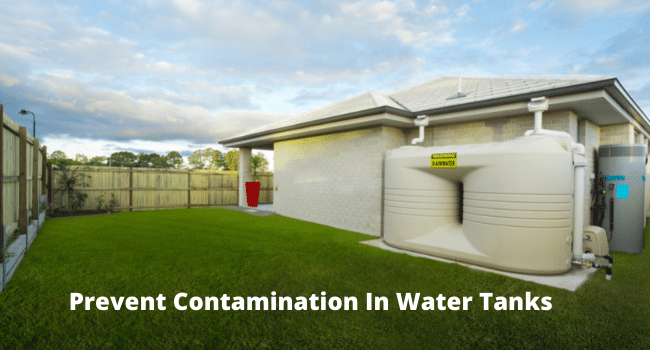Table of Contents
Having safe drinking water is a crucial part of quality living for you and your family. Household water should be free from harmful chemicals and germs. If you have a water collection tank at home, it’s up to you to reduce your risk of water-borne diseases due to a contaminated water tank.
Water Collection Tanks
Whether for your home or business, you can store water using water collection tanks. There are various types of tanks to choose from according to your needs. The Water Tank Factory, for example, has round tanks, slimline tanks, or underground tanks.
Using a water tank, you can collect water from the following sources:
- Spring
- Boring a deep hole in the ground
- Natural water from lakes or streams
- Rainwater
However, improper maintenance of your water tank can make water stored inside unsafe for use. Below are some situations when water can become unsafe:
- Bore water may contain chemicals that are corrosive or hard
- Water from springs, streams, lakes, or shallow bores may have harmful chemicals, germs, or unpleasant taste
- Rainwater collected from the roof may become contaminated with dirt, bird feces, agricultural spray, dust, or ash
If you’re unsure about the water quality you have at home, you can have it tested by a laboratory.
Causes Of Water Contamination
Water contamination can trigger serious health conditions such as vomiting and diarrhea, which can be potentially dangerous for people who have compromised immune systems, the elderly, and infants.
There are several factors that lead to water contamination in your tanks. These include the following:
- Holes or cracks in partially buried tanks
- Chemical residues from the soil, agricultural spray drift, and ash
- Soil, leaves, and other debris getting into the tank
- Dead insects or animals, bird and other animal droppings in the tank or gutters
- Germs and viruses from bird or animal feces getting into the tank
Also Check – rainwater tank
Preventing Water Contamination
There are several ways to ensure that water contamination doesn’t happen to your collected water in tank collection systems. Follow these steps to prevent water contamination in water tanks.
1. Ensure Safety And Quality Of Collected Rainwater
- Install the water tank system properly.
- Check that your roof surface is appropriate for rainwater collection.
- Use only safe roof paint by choosing one that’s appropriate for rainwater collection.
- Use gutters and plastic pipes appropriate for rainwater collection.
- Use a gutter mesh to keep debris such as leaves from blocking the gutters.
- Install a fine mesh to screen debris and a first flush diverter, which will divert the first flush of water when it rains.
- Use insect-proof screens at the ends of tank overflow outlets to keep pests and mosquitoes out. Make sure that the tank is vented correctly.
- Cover the tank to keep birds, animals, insects, and other matter from getting inside.
- Part of your property maintenance should be roof clearing. Roofs should be clear of overhanging vegetation to prevent debris and leaves from getting into the catchment. Overhanging branches will also give cats, rodents, and other animals access to your roof and let birds roost above it.
2. Avoid Fecal Contamination
- Disconnect the pipes connecting the water to your tank.
- Clean the roof of droppings by mixing ten liters of water with half a teaspoon of plain, fragrance-free bleach. Use the mixture in scrubbing the roof and flushing the material.
- Rinse or flush the material thoroughly with clean water.
- Reconnect the pipes.
3. Clean Your Gutters
- Disconnect the pipes that transfer water to the tank.
- Clean the debris that has accumulated in the gutters.
- Flush the gutter of animal droppings and dirt using clean water.
- Reconnect the pipes.
4. Clean The Water Tank
- Water tanks should be checked yearly and cleaned if needed. Tank cleaning is ideally done by cleaning contractors. If you attempt to clean the tank yourself, make sure that there’s enough ventilation and someone else is there to assist you.
- Cleaning the tank should only include removing leaves, accumulated sediment, and other objects that got inside the tank.
- Remove sediment by doing any of the following:
- Use a swimming pool vacuum cleaner.
- Place an inverted funnel at the end of a hose and move it along the tank bottom.
- Install an automatic tank vacuum system to draw off sediment from the tank bottom when the tank water overflows.
Plastic stock tank: They may seem like ordinary containers at first glance, but don’t be fooled by their unassuming appearance. These durable and flexible tanks have become the secret weapon of resourceful individuals everywhere who are looking for affordable and practical solutions in various aspects of their lives. Whether you need an emergency water supply during natural disasters or want to create an impressive hydroponic system in your basement, here we unveil the fascinating potential hidden within these humble plastic stock tanks.
Final Thoughts
Having your potable water tank inspections isn’t enough to prevent contamination. If the tank is dirty, then it obviously needs cleaning. Once you discover that the screens and tank openings are damaged, then they should be fixed immediately. Preventing contamination in water tanks entails regular cleaning and checking, so it’s best to include this in your maintenance routine.
Read More on KulFiy
